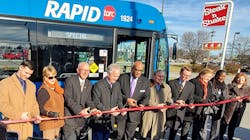Transit Authority of River City (TARC) inaugurated what Louisville Mayor Greg Fischer called “next level” service with the launch of Rapid, the region’s first bus rapid transit (BRT) system on Jan. 6.
The BRT service, which is part of the $35-million New Dixie Highway Project, will offer improved bus service along one of TARC’s busiest corridors connecting the Gene Snyder in Valley Station to downtown Louisville.
“The New Dixie Highway Project is a key piece of our MOVE Louisville initiative, and the rapid transit system is a game-changer,” said Mayor Fischer. “This is ‘next level’ service on one of the city’s busiest routes and a great innovative option for people traveling the corridor on their way to work and school.”
The Dixie Highway Dixie is described as one of the busiest, widest and dangerous transportation corridors in the city with a fatality rate more than three times the rate of similar highways. With more than 60,000 drivers and more than 4,000 transit riders depending on the corridor daily, the New Dixie Highway Project focused on improving safety, enhancing traffic flow and creating a more efficient and more reliable transit service for TARC riders.
“This new service will improve the lives of those who use public transportation for work, school, shopping or medical appointments along the route,” Kentucky Gov. Andy Beshear said. “While adding shelters to reduce exposure to the weather, the improvements also make Dixie Highway safer for drivers and pedestrians. I look forward to continuing to work with local, state and federal partners to better our communities throughout the commonwealth.”
Service on the new BRT route occurs every 15 minutes during weekdays and the route serves 37 distinctive BRT stops along the length of the Dixie Highway corridor and into downtown. The city notes that the newly branded shelters and pylons also offer a new look and feel to the Dixie Highway corridor.
In addition to the new shelters and stops, the Rapid BRT project features TARC-designated queue-jump lanes and bus turnouts that make it safer and easier for buses to re-enter traffic after stops, a Traffic Signal Priority system connected with the Intelligent Transportation System, nine newly branded buses designated for the Dixie Highway corridor and sidewalk improvements to improve access to bus rapid transit stations.
“The Rapid will improve safety and convenience, while creating a stronger connection between downtown and the Dixie Highway corridor—as far south as the Gene Snyder Freeway,” said Ferdinand L. Risco Jr., TARC executive director. “As our area’s first rapid transit system, the BRT will introduce enhanced customer service and connectivity, and encourage new economic growth for the region.”
The New Dixie Highway Project broke ground in December 2017 and most major construction wrapped up a few weeks ago. While Rapid BRT service began Jan. 6, some of the technological components will continue to come online in the following weeks. The city also notes that final surfacing and striping will be installed along Dixie Highway in the spring.
“Dixie Highway has been a congested and dangerous roadway for far too long,” said Rep. John Yarmuth. “Today’s launch of Rapid—and the larger $35 million investment in the New Dixie Highway Project—will make this corridor safer and more efficient for drivers, pedestrians and TARC riders. This is a vital stretch of road in an important part of our city, state and region.”

Mischa Wanek-Libman | Group Editorial Director
Mischa Wanek-Libman is director of communications with Transdev North America. She has more than 20 years of experience working in the transportation industry covering construction projects, engineering challenges, transit and rail operations and best practices.
Wanek-Libman has held top editorial positions at freight rail and public transportation business-to-business publications including as editor-in-chief and editorial director of Mass Transit from 2018-2024. She has been recognized for editorial excellence through her individual work, as well as for collaborative content.
She is an active member of the American Public Transportation Association's Marketing and Communications Committee and served 14 years as a Board Observer on the National Railroad Construction and Maintenance Association (NRC) Board of Directors.
She is a graduate of Drake University in Des Moines, Iowa, where she earned a Bachelor of Arts degree in Journalism and Mass Communication.


